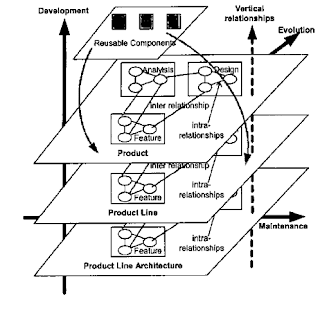In general, the SAR approaches can be classified as Bottom-Up, Top-Down and Hybrid. In the Bottom-Up approach, starts with the low level knowledge, such as source-code, and progressively tries to reach the higher level understanding using reverse engineering. The Top-Down approach is the opposite, as it begins with high-level concepts, such as architectural views and requirements, and tries to build the architecture through hypotheses that are confirmed by the source-code. The Hybrid approach merges the last two approaches, abstracting the low-level knowledge and refining the high-level knowledge ratifying correspondences between both the conceptual and concrete architectures.
In the SAR approaches we can have inputs of architectural nature, like viewpoints and styles, and non-architectural inputs, like souce-code, human knowledge, etc. As output we can have, for example, visual software views, the architectural conformance and the architecture analysis.
Some approaches that aim at the investigation of reuse and software product line (SPL) migration have been identified: ARES[2], ARMIN[3][4], MAP[5] and PULSE[6]. As a goal for these approaches we can highlight the identification of commonalities, variabilities, components that can be extracted of pre-existing systems that, for example, might be turned into services.
Now, our studies focus on identifying if SAR can be used as a tool to support the introduction of reuse in organizations. Our main challenges are:
– What approaches are more complete/ to introduce Reuse?
– What approach can we use?
– Are the companies producing these artifacts?
– Can these processes be agile?
– How much of this processes can be automated?
– How to systematize this approach?
[1] D. Stéphane, P. Damien, "Software Architecture Reconstruction: A Process-Oriented Taxonomy", IEEE Transactions on Software Engineering., Vol 35, No. 4, 2009.
[2] W. Eixelsberger, M. Ogris, H. Gall, and B. Bellay, “Software Architecture Recovery of a Program Family,” Proc. Int’l Conf. Software Eng., pp. 508-511, 1998.
[3] R. Kazman, L. O’Brien, and C. Verhoef, “Architecture Reconstruction Guidelines,” technical report, third ed., Carnegie Mellon Univ., SEI, 2003.
[4] L. O’Brien, D. Smith, and G. Lewis, “Supporting Migration to Services Using Software Architecture Reconstruction,” Proc. Int’l Workshop Software Technology and Eng. Practice, pp. 81-91.
[5] C. Stoermer and L. O’Brien, “Map—Mining Architectures for Product Line Evaluations,” Proc. Working IEEE/IFIP Conf. Software Architecture, pp. 35-41, 2001.
[6] J. Knodel, D. Muthig, M. Naab, and M. Lindvall, “Static Evaluation of Software Architectures,” Proc. Conf. Software Maintenance and Reeng., pp. 279-294, 2006.


















